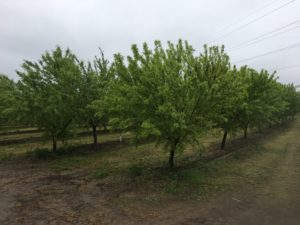
It is very common to see yellow trees in the spring. The lack of color is often due to saturated soils which reduces the movement of oxygen into the soil, killing fine feeder roots. This impacts the ability for the tree to take in water and nutrients, leading to micro-nutrient deficiencies, impacting nut set and tree growth. In severe cases, especially with younger trees, the symptoms are similar to glyphosate drift or zinc deficiency. Later-season carry-over effects are also observed and include a limited rootzone, which leads to severe water stress during hull-split and harvest.
Most of the time, this problem is caused by the orchard being irrigated too soon. Many operations apply water because it is perceived as needed or they are wanting to apply fertilizer. The need to apply water, however, is usually very low in the spring due to the cooler conditions and crop stage. Based on the 30-year average almond evapotranspirational values across California, water use from Mid-February (bloom) through the first week of April for almonds across the State ranges from 3.6″ to about 4.25.” This demand is often met by rain and the tree accessing stored moisture within the soil.
To determine when to start applying water, plant stress or soil moisture levels should be monitored. The soil profile should be starting to dry at the two to three feet zone and can be checked with with the use of a shovel, auger, or soil moisture sensors. If using the pressure chamber to monitor plant stress, irrigation should be considered when trees are 1.5-2 bars more negative than baseline. For more information on the use of a pressure chamber in perennial crops, please see this document. If wanting to apply nitrogen, applications should occur by ground application or the shortest fertigation set as possible. These practices will help to properly time the first irrigation, reducing the occurrence of yellow trees.
To provide an example how long water can be withheld from an orchard in the spring, last year (2016) in a local research plot near Delhi, CA (very sandy soil), we applied the first irrigation on April 29th when stem water potential readings reached 1.5 bars more negative than baseline. By that time, the neighboring blocks were irrigated three times. We estimated that the grower saved $15/acre in a reduction in pump and water costs. Although it is common for trees not to need much applied water through the beginning of April, the late rains of 2016 provided the water needed by the trees. This, of course, does not happen every year, and illustrates the point of monitoring tree or soil water status in determining when to irrigate.


Mike Buttress
April 10, 2017David!
I often think of you. You’re doing a great job and I continue to enjoy reading your articles. Thanks.
Regarding the yellow trees we have been encountering, I would like to add some of my own experiences – even in my own back yard. Have you noticed that when there is a relatively thin offshoot from a recent pruning, that the offshoot may display yellow leaves at the beginning of the season? The rest of the tree will appear totally normal/healthy. I assumed that it was due to rapid growth but restricted translocation in the smaller shoots.
Cheers,
Mike
David Doll
April 11, 2017Hey Mike,
Hopefully, retirement is treating you well.
You are correct and thanks for sharing. Transient micro-nutrient deficiencies can occur in the spring, especially with vigorously growing shoots and in cool conditions (due to lack of mass-flow movement of nutrients). As you know, there are many causes of yellow looking trees – including soil pH, low nitrogen, etc. In my experience, however, I often find that within almond and walnut, the primary culprit of yellow trees in the spring is saturated soils. This, of course, is easy to check and can be determined with a quick check of the soil. If the soil is dry, then other causes can be investigated.
Thanks for the thoughts/comments and kudos. I always appreciate your insight.
David
Yellow Almond Trees More Widespread? | AgNet West
April 20, 2017[…] Find more information about yellowing trees from Doll’s blog post on The Almond Doctor website. […]